The Manifold Absolute Pressure Sensor Market is estimated to be valued at USD 935.6 million in 2025 and is projected to reach USD 1384.9 million by 2035, registering a compound annual growth rate (CAGR) of 4.0% over the forecast period.
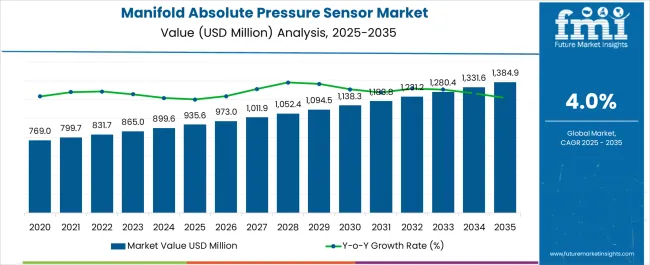
| Metric | Value |
|---|---|
| Manifold Absolute Pressure Sensor Market Estimated Value in (2025 E) | USD 935.6 million |
| Manifold Absolute Pressure Sensor Market Forecast Value in (2035 F) | USD 1384.9 million |
| Forecast CAGR (2025 to 2035) | 4.0% |
The Manifold Absolute Pressure Sensor market is witnessing steady growth, driven by the increasing adoption of advanced engine management systems and the demand for improved fuel efficiency and reduced emissions. These sensors are critical for monitoring engine performance by measuring the absolute pressure in the intake manifold, enabling optimized air-fuel mixture and combustion efficiency. Rising vehicle production, particularly in emerging markets, is supporting demand for reliable and cost-effective sensor solutions.
The growing focus on emission regulations and fuel economy standards is further accelerating adoption, as sensors enable compliance with stringent government mandates. Technological advancements, such as improved sensor accuracy, durability, and integration with electronic control units, are enhancing performance and reliability.
Additionally, the shift toward electrification and hybrid vehicles is encouraging the adoption of advanced sensors capable of supporting complex engine configurations As automotive manufacturers prioritize engine efficiency, emission reduction, and overall vehicle performance, the Manifold Absolute Pressure Sensor market is expected to sustain long-term growth, supported by technological innovation and increasing vehicle penetration worldwide.
The manifold absolute pressure sensor market is segmented by vehicle type, product type, and geographic regions. By vehicle type, manifold absolute pressure sensor market is divided into Passenger Car, LCV (Light Commercial Vehicle), and HCV (Heavy Commercial Vehicle). In terms of product type, manifold absolute pressure sensor market is classified into 1 Bar, 2 Bar, 3 Bar, and 4 Bar.
Regionally, the manifold absolute pressure sensor industry is classified into North America, Latin America, Western Europe, Eastern Europe, Balkan & Baltic Countries, Russia & Belarus, Central Asia, East Asia, South Asia & Pacific, and the Middle East & Africa.
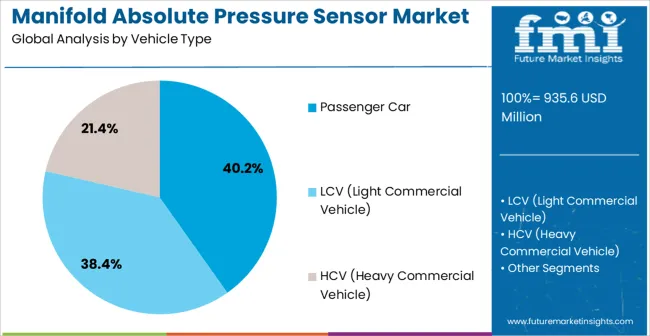
The passenger car vehicle type segment is projected to hold 40.2% of the market revenue in 2025, establishing it as the leading vehicle category. Growth in this segment is being driven by the rising production and adoption of passenger vehicles in both developed and emerging regions. Manifold absolute pressure sensors are increasingly being integrated into passenger car engines to optimize fuel efficiency, enhance performance, and ensure compliance with stringent emission regulations.
Advanced sensor technologies enable precise monitoring of air intake pressure, which supports real-time engine control and improved combustion. Manufacturers are also leveraging these sensors to achieve lower fuel consumption, reduced emissions, and improved drivability, which are key factors influencing consumer preference.
The ability to integrate sensors into diverse engine types, including gasoline, diesel, and hybrid powertrains, has further strengthened their adoption As automotive production continues to expand and emission standards become more rigorous, the passenger car segment is expected to maintain its leadership, driven by the ongoing need for efficiency, reliability, and regulatory compliance.
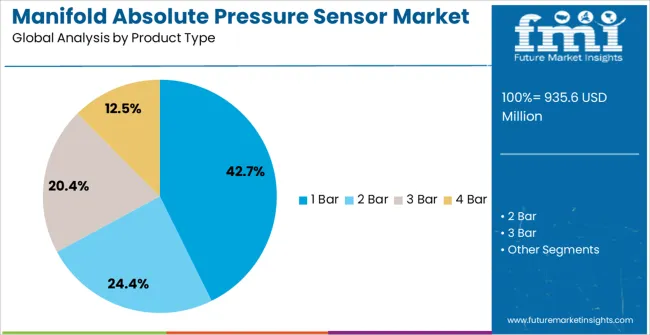
The 1 bar product type segment is expected to account for 42.7% of the market revenue in 2025, making it the leading product category. Its growth is being driven by its suitability for a wide range of automotive applications, particularly in passenger cars and light-duty vehicles. 1 bar sensors offer precise pressure measurement capabilities, enabling optimized engine performance and efficient fuel management.
Integration with engine control units allows real-time monitoring of air intake and improved combustion efficiency, which reduces fuel consumption and emissions. The durability, accuracy, and cost-effectiveness of 1 bar sensors have reinforced their preference among automotive manufacturers. Increasing focus on meeting fuel economy standards and emission regulations globally is further supporting their adoption.
With technological advancements in sensor design and manufacturing, 1 bar sensors are able to provide reliable performance even under high-temperature and variable pressure conditions As demand for fuel-efficient and emission-compliant vehicles grows, the 1 bar segment is expected to maintain its leading market position, supported by its versatility and proven reliability in engine management systems.
A sensor is a device that records a change in physical properties and responds to it. Modern automobiles use a series of sensors connected to a computer to control various operations. A Manifold Absolute Pressure (MAP) sensor is used for two specific purpose - to measure the biometric pressure and to inform the powertrain control module about the engine load.
This information given to the powertrain control module is used to maintain & adjust fuel enrichment and ignition timing under different operating conditions. Manifold absolute pressure sensors provide instantaneous information about absolute pressure to the powertrain control unit. Intake vacuum drops to open the throttle when engine is working hard and requires more fuel to maintain the air fuel ratio.
In case of deceleration, power required by the engine decreases comparatively and thus, the throttle closes itself. The intake electronic control unit responds to this by reducing fuel consumption and increasing the ignition timing. The main purpose of a manifold pressure sensor is to control fuel injection. Manufacturers are launching microprocessor-based powertrain control units with technologically advanced sensors that are more accurate.
This will force the consumers to replace their old sensors with the advanced ones. This is expected to propel the manifold pressure sensor global market over the estimated time. Consumers are becoming increasingly concerned about safety and security and this will drive the manifold absolute pressure sensor global market over the estimated time.
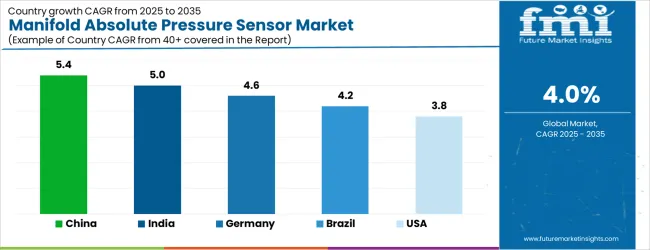
| Country | CAGR |
|---|---|
| China | 5.4% |
| India | 5.0% |
| Germany | 4.6% |
| Brazil | 4.2% |
| USA | 3.8% |
| UK | 3.4% |
| Japan | 3.0% |
The Manifold Absolute Pressure Sensor Market is expected to register a CAGR of 4.0% during the forecast period, exhibiting varied country level momentum. China leads with the highest CAGR of 5.4%, followed by India at 5.0%. Developed markets such as Germany, France, and the UK continue to expand steadily, while the USA is likely to grow at consistent rates.
Japan posts the lowest CAGR at 3.0%, yet still underscores a broadly positive trajectory for the global Manifold Absolute Pressure Sensor Market. In 2024, Germany held a dominant revenue in the Western Europe market and is expected to grow with a CAGR of 4.6%.
The USA Manifold Absolute Pressure Sensor Market is estimated to be valued at USD 330.3 million in 2025 and is anticipated to reach a valuation of USD 330.3 million by 2035. Sales are projected to rise at a CAGR of 0.0% over the forecast period between 2025 and 2035. While Japan and South Korea markets are estimated to be valued at USD 47.1 million and USD 24.0 million respectively in 2025.
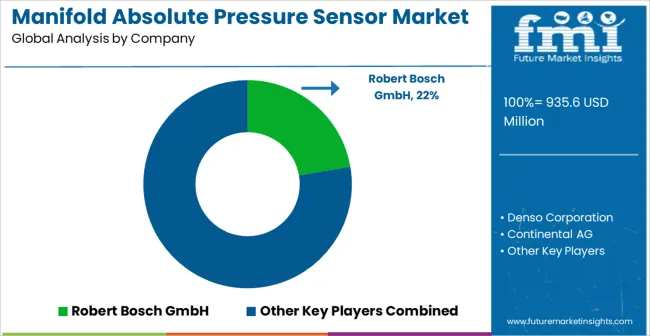
| Item | Value |
|---|---|
| Quantitative Units | USD 935.6 Million |
| Vehicle Type | Passenger Car, LCV (Light Commercial Vehicle), and HCV (Heavy Commercial Vehicle) |
| Product Type | 1 Bar, 2 Bar, 3 Bar, and 4 Bar |
| Regions Covered | North America, Europe, Asia-Pacific, Latin America, Middle East & Africa |
| Country Covered | United States, Canada, Germany, France, United Kingdom, China, Japan, India, Brazil, South Africa |
| Key Companies Profiled | Robert Bosch GmbH, Denso Corporation, Continental AG, Honeywell Corporation, BorgWarner Inc., NXP Semiconductors, TE Connectivity, Hitachi Automotive Systems, Ltd., Sensata Technologies, and Infineon Technologies AG |
The global manifold absolute pressure sensor market is estimated to be valued at USD 935.6 million in 2025.
The market size for the manifold absolute pressure sensor market is projected to reach USD 1,384.9 million by 2035.
The manifold absolute pressure sensor market is expected to grow at a 4.0% CAGR between 2025 and 2035.
The key product types in manifold absolute pressure sensor market are passenger car, lcv (light commercial vehicle) and hcv (heavy commercial vehicle).
In terms of product type, 1 bar segment to command 42.7% share in the manifold absolute pressure sensor market in 2025.






Our Research Products

The "Full Research Suite" delivers actionable market intel, deep dives on markets or technologies, so clients act faster, cut risk, and unlock growth.

The Leaderboard benchmarks and ranks top vendors, classifying them as Established Leaders, Leading Challengers, or Disruptors & Challengers.

Locates where complements amplify value and substitutes erode it, forecasting net impact by horizon

We deliver granular, decision-grade intel: market sizing, 5-year forecasts, pricing, adoption, usage, revenue, and operational KPIs—plus competitor tracking, regulation, and value chains—across 60 countries broadly.

Spot the shifts before they hit your P&L. We track inflection points, adoption curves, pricing moves, and ecosystem plays to show where demand is heading, why it is changing, and what to do next across high-growth markets and disruptive tech

Real-time reads of user behavior. We track shifting priorities, perceptions of today’s and next-gen services, and provider experience, then pace how fast tech moves from trial to adoption, blending buyer, consumer, and channel inputs with social signals (#WhySwitch, #UX).

Partner with our analyst team to build a custom report designed around your business priorities. From analysing market trends to assessing competitors or crafting bespoke datasets, we tailor insights to your needs.
Supplier Intelligence
Discovery & Profiling
Capacity & Footprint
Performance & Risk
Compliance & Governance
Commercial Readiness
Who Supplies Whom
Scorecards & Shortlists
Playbooks & Docs
Category Intelligence
Definition & Scope
Demand & Use Cases
Cost Drivers
Market Structure
Supply Chain Map
Trade & Policy
Operating Norms
Deliverables
Buyer Intelligence
Account Basics
Spend & Scope
Procurement Model
Vendor Requirements
Terms & Policies
Entry Strategy
Pain Points & Triggers
Outputs
Pricing Analysis
Benchmarks
Trends
Should-Cost
Indexation
Landed Cost
Commercial Terms
Deliverables
Brand Analysis
Positioning & Value Prop
Share & Presence
Customer Evidence
Go-to-Market
Digital & Reputation
Compliance & Trust
KPIs & Gaps
Outputs
Full Research Suite comprises of:
Market outlook & trends analysis
Interviews & case studies
Strategic recommendations
Vendor profiles & capabilities analysis
5-year forecasts
8 regions and 60+ country-level data splits
Market segment data splits
12 months of continuous data updates
DELIVERED AS:
PDF EXCEL ONLINE
BPS Pressure Sensors Market Size and Share Forecast Outlook 2025 to 2035
Oil Pressure Sensor Market Size and Share Forecast Outlook 2025 to 2035
Air Pressure Sensor Market - Outlook 2025 to 2035
MEMS Pressure Sensor Market Size and Share Forecast Outlook 2025 to 2035
Automotive Pressure Sensor Market Size and Share Forecast Outlook 2025 to 2035
Strain Type Pressure Sensors Market Size and Share Forecast Outlook 2025 to 2035
Quartz High-Pressure Sensors Market Size and Share Forecast Outlook 2025 to 2035
Compact Pneumatic Pressure Sensor Market Size and Share Forecast Outlook 2025 to 2035
Pressure Relief Dressing Market Size and Share Forecast Outlook 2025 to 2035
Pressure Compensated Hydraulic Pump Market Size and Share Forecast Outlook 2025 to 2035
Sensor Data Analytics Market Size and Share Forecast Outlook 2025 to 2035
Sensor Testing Market Forecast Outlook 2025 to 2035
Pressure Compensated Pump Market Size and Share Forecast Outlook 2025 to 2035
Pressure Switch Market Forecast Outlook 2025 to 2035
Pressure Reducing Valve Market Size and Share Forecast Outlook 2025 to 2035
Pressure-Volume Loop Systems Market Size and Share Forecast Outlook 2025 to 2035
Pressure Transmitter Market Size and Share Forecast Outlook 2025 to 2035
Sensor Fusion Market Size and Share Forecast Outlook 2025 to 2035
Sensor Based Glucose Measuring Systems Market Size and Share Forecast Outlook 2025 to 2035
Sensor Development Kit Market Size and Share Forecast Outlook 2025 to 2035

Thank you!
You will receive an email from our Business Development Manager. Please be sure to check your SPAM/JUNK folder too.
Chat With
MaRIA